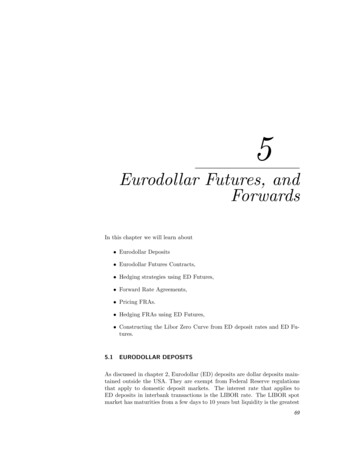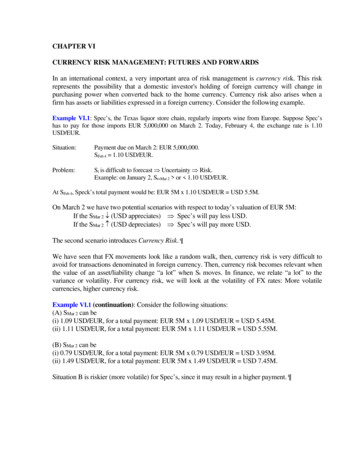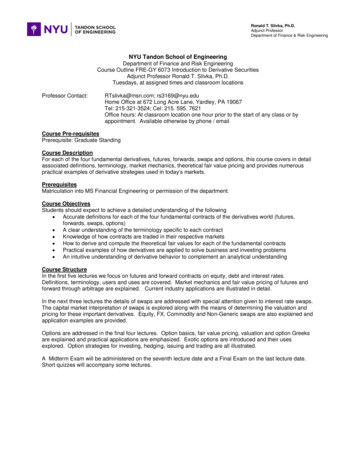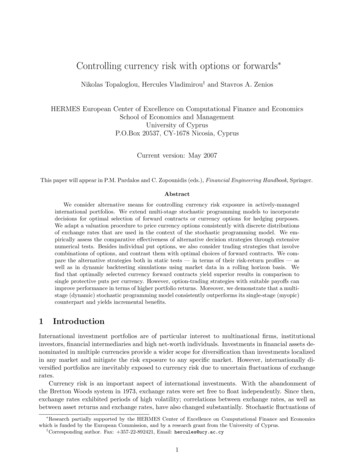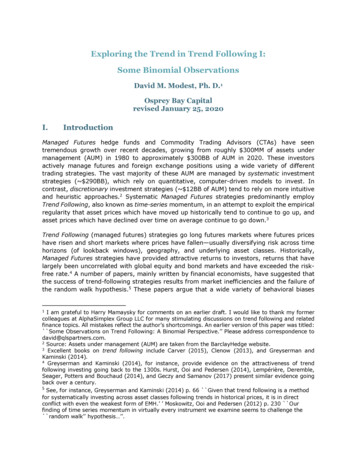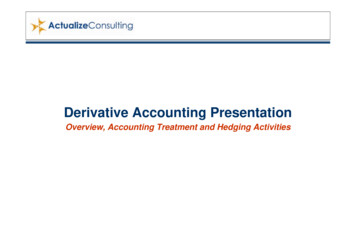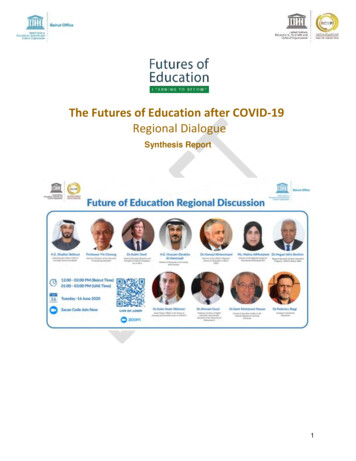
Transcription
The Futures of Education after COVID-19Regional DialogueSynthesis Report1
ContextCOVID-19 has caused education disruptions and prolonged school closures all around the world,which affected 90% of the world’s student population and led most countries to think aboutalternative ways of providing education to ensure that learning never stops1. Keeping educationcontinuity in mind, most countries rushed to online distance education using online platforms, elearning, and ICTs, which set off an unplanned and rapid shift in the education sector, opened thedoor to many opportunities, highlighted existing and new disparities and gave rise to severalchallenges.In regards to this rush to online and distance education, the World Economic Forum cited WangTao, Vice President of Tencent Cloud and Tencent Education, to highlight that the way forward isto further harness available technologies and the internet in education and that online educationwill become an integral component of school education.2 Yet, due to such an abrupt shift fromschool closures due to COVID-19, most teachers around the world were forced to deliver onlinelearning without proper training, and support or time for preparation but being plied with diversenew tools; they had to digitize their course contents and/or develop new contents.Concerning equity and digital divide, there are mainly two different perspectives. Jang and Weller,based on the United Nations (2018)3, anticipated that technology would leverage inclusive andalternative education of marginalized and disadvantaged groups by benefitting from new ways oflearning and participation4. Whereas, disparities in access to distance learning across countriesand income brackets necessitate special attention by international communities. For instance,UNESCO identified that certain groups of students, such as those from low-income families,ethnic or religious minorities, migrants, in precarious home situations, in remote rural areas orwith special needs, may require particular consideration and specific strategies when it comes todistance learning during COVID-195.Against this backdrop, the following are key questions that are frequently raised across the regionand that led UNESCO Regional Bureau for Education in the Arab States – Beirut (hereinafterreferred to as UNESCO Beirut) in partnership with the Regional Center for Educational Planning1UNESCO COVID-19 education response: Virtual knowledge-sharing workshop on distance educationprogrammes using radio and television, 27 May 2020: summary 3735762World Economic Forum. April 2020. The COVID-19 pandemic has changed education forever. This ishow. United Nations. 2018. Technologies and the future of learning and education for all, discussion noteprepared through the High-level Committee on Programmes (HLCP) under the leadership of UNICEF andUNESCO, with support from other UN agencies, First Regular Session of 2018 (May 2018, London).4Jang, A. and Weller, C. 2019. The future of work and the teaching profession: background paper forJoint ILO–UNESCO Committee of Experts on the Application of the Recommendations concerningTeaching Personnel. https://www.ilo.org/wcmsp5/groups/public/---ed dialogue/--sector/documents/meetingdocument/wcms 675238.pdf5UNESCO, 2020 issue note n.2.1: Distance learning strategies in response to COVID-19 schoolclosures. 2
(RCEP) and Education Research and Foresight unit at UNESCO Headquarters to co-organize aregional dialogue on Futures of Education after COVID-19 on 16 June 2020. What are the lessons learned from the challenges that faced education systems duringthe pandemic? How can we benefit from these lessons to shape the future of education?What are the priorities that education systems should focus on when developing theirplans and programs in the future?What is Pedagogy 4.0?How do we ensure that the scenarios envisaged for the future of education are moreinclusive and bridge educational and learning gaps?This webinar was built upon the achievement of the 2017 regional think tank seminar on“Rethinking Education” organized in Sharm EL Sheikh, Egypt and reaffirms the 2016 CairoDeclarations for rethinking education. It was carried out within the framework of UNESCO’sEducation Response to the COVID-19 crisis and the organization’s continuous support for ArabMember States during and after COVID-19, and as part of the global Futures of Educationinitiative launched by UNESCO in September 2019.Objectives and participationThe webinar aimed to examine the impact of COVID-19 on educational continuity in the Arabregion, to reflect on the lessons learnt from the challenges faced during the COVID-19 crisis, andto explore and analyze scenarios and strategies proposed to reshape the vision of education afterCOVID-19.From the 2,700 people who registered, only 500 participants were able to join the webinar due totechnical limitations. Those included representatives of Ministries of education of participatingcountries, members of the Arab Regional Support Group for SDG 4, representatives from theArab Region Global Steering Committee, the Arab Regional Task Force, including UNESCO’sregional and field offices, Category 2 centres (RCEP, RCQE, ASFEC) and key partners (ABEGand ALECSO), in addition to key education stakeholders pertinent to the dialogue.The welcoming speechesDr. Hegazi Idris Ibrahim, UNESCO Beirut (Arabic)Dr. Hegazi Idris Ibrahim, Programme Specialist for Basic Education at UNESCO Beirut,highlighted the questions that the regional discussion aimed to respond, namely: What are the educational policies and opportunities that we can benefit from for the futureof education in the Arab Region? What do we mean by “new pedagogy” or “pedagogy 4.0”? What are the necessary practices to ensure education continuity, especially in crisisaffected countries and for out-of-school children?3
What about children with special needs now and in the future?What are the lessons learnt about parents’ role in learning and education?Are children in need of any psychosocial support now and after returning to school ?What is UNESCO’s Global Initiative on the Future of Education 2050?Dr. Mahra Al Mutaiwei, RCEP (Arabic)Dr. Mahra stated that one of RCEP’s visions is to build the capacities of Arab and Gulf states tobetter plan for the future of education. Therefore, RCEP has exerted unwavering efforts to targetand meet the needs of Arab countries in its programmes, and reexamined, reviewed and modifiedits strategies and plans to serve education systems in the region through capacity-building andknowledge-sharing activities. The main points of the intervention are recapped hereunder.The COVID-19 pandemic took its toll on education systems around the world and cast a shadowon the future of education, as the crisis affected the education of 1.6 billion students acrossdifferent school levels preventing them from going to school and university and engaged indistance learning. This has pushed education stakeholders to think out of the box to provideunconventional and alternative education modalities based on the use of the internet, radio andTV, which resulted in some constructive and positive changes as well as concerns on ensuringquality of distance education provided.Key recommendations drawn from RCEP are as follows: Education systems should explore new methods to train and prepare teachers andeducators, so they may attain the required skills and competencies to keep up with thechanges in the field of education. Education systems should review and upgrade the range of skills provided to students ina way that would better equip and prepare them for the future. Educational systems should undertake new measures for benchmarking the quality ofeducation and tackling the current digital divide. It is essential and inevitable to develop a worldwide framework for coordination andcooperation and initiate effective and operative partnerships between public and privateinstitutions with the aim of providing equitable and quality education to all students aroundthe world.Opening remarksDr. Hamed Al Hammami, UNESCO Beirut (Arabic)Dr. Hamed started by stressing the potential transformations of education as well as the featuresof teaching and learning in the Arab Region after COVID-19. The main points of the interventionare detailed hereunder.It is critical to draw lessons from the challenges faced by Ministries of Education and educationsystems during this pandemic, which includes but is not limited to:4
unpreparedness of some education systems in the Arab Region to provide remotelearning;weak educational infrastructure;inequality in accessing the internet; andteachers’ unpreparedness to switch to remote learning.Education is undergoing unprecedented difficulties and challenges during the pandemic.However, the current crisis can be turned into an opportunity by building a more resilient educationsystem. To achieve this transformation, we should exert effort to: capitalize on IT; provide vocational training for teachers and enhance their capacities; review assessment methods; engage in a comprehensive digital transformation; build effective partnerships; and review old educational philosophies, as well as the goals and outputs of the educationalsystem, to be in line with recent developments as well as with labor market requirements.The future of education in UAE after COVID-19H.E. Hussain Ibrahim Al Hammadi, Minister of Education in UAE (Arabic)The UAE's response to the COVID-19 crisis in the educational sectorThe UAE launched the Mohammed bin Rashid Smart Learning Programme in 2012. TheProgramme aims to build solid educational infrastructure, train teachers and prepare students touse technological devices in education. At first, it was only used for distance learning in specificcases such as students’ traveling and absence from school. Amid the COVID-19 pandemic andthe trend of distance education, Spring break was brought forward by two weeks for Ministries ofEducation to be equipped with strategies to mitigate education disruption, thereby allowing themto improve education approaches, train teachers and prepare to launch the Smart LearningProgramme for nearly 1.2 million students from different schools and universities. Enrollment ratereached 100% in all levels of education, from KG-1 to tertiary education, in Emirati schools - whichincludes private schools. The effective implementation of the smart learning system requires thefollowing: Training teachers building their capacities and preparing them to provide distance learningand education; Creating, adapting and harmonizing curricula for distance learning;COVID-19 global impact on educationIn the short term, Positive impact: Increased attention and appreciation to distance learning systems,5
Growing appreciation and understanding of teachers’ role in the community, andprovision of technical development opportunities related to distance learning forteachers,Establishing regional and international partnerships in the field of technology.Negative impact: Existing gap in distance learning implementation on the national and internationallevels, Variation of students’ academic attainment based on the ability of educationalinstitutions and countries to provide distance learning, Negative impact on students, teachers and parents’ quality of life during lockdown.In the long term, Positive impact: Increasing the scope and reach of education to all segments of society Redefining the role of schools and developing assessment policies; Developing innovative models for higher education and preparing students for newjobs; Increasing research and entrepreneurship; Establishing partnerships between the public and private sectors. Negative impact: Possible inequality related to educational services provided to students; Decreasing academic attainment in countries that lack technological means toprovide distance learning; Difficulties in measuring learning outcomes due to undeveloped studentperformance assessment systems.Opportunities of the educational sector after the pandemicBy addressing the challenges and building on the success UAE have achieved, we can maximizethe learning opportunities, ensure quality, fair and inclusive education, and enhance learningopportunities for all through 4 main themes as follows:1. Possibilities for developing the educational system2. Improving learning outcomes3. Measuring the quality of education system outputs4. Partnerships between countries and organizations in the education sector to achieve SDG4To seize aforementioned opportunities, recommendations were drawn up to: Enable infrastructure, make it available for everyone and ensure that it can accommodateall updates occurring in educational platforms and resources; and ensure mutualcollaboration and support among organizations, institutions and states to empowerunderprivileged areas;6
Establish regulatory policies and frameworks to handle emergencies and ensure qualityand equity in education in all circumstances;Improve curricula to accommodate different teaching and learning methods, especially thepractical ones;Habilitate, train and enable teachers and education authorities to develop their teachingand learning methods for lifelong learning, optimise distance learning and adapt to thechanging reality of the educational process.Smart EducationSmart Education is not an option, but rather a strategic choice that has to be integrated ineducation systems. Arab countries should invest in building their capacities to make smarteducation available for everyone, given that this type of education can be delivered throughmobiles, computers, tablets, etc.New delivery methods & complementarity between school and university educationIt is also important to find new ways to deliver educational activities to grasp students’ attentionand help them build their capacities and develop their skills. In addition, complementarity betweenschool and university education is essential to avoid confusion among students when theytransition from senior year at school to the first year of university. It might be helpful to allow highschool students to take a few university classes to help them get acquainted with universityteaching methods and educational contents.Measuring the quality of the education system outputsMonitoring and evaluating the performance of the education system Build a comprehensive framework for monitoring and evaluating the performance of thesmart education system, which includes the quality of outputs and their alignment withinputs.Establishing a smart measuring system Establish a smart, reliable, accurate and innovative measuring system to monitor students’performance in different teaching and learning patterns, and complement the system witha feedback mechanism that involves students, teachers and parentsMeasuring Impact Invest in research programmes to measure the impact of expected changes on educationsystems, find scientific solutions for related challenges, and Share best practices to improve education systems and ensure quality.Partnerships for educationIt is important to do the following to promote and develop the education sector:7
Training parents and guardians for them to support their children’s learningCreating specialized platforms for capacity-building and skill-development targetingstudents, teachers and education authorities;Promoting opportunities to exchange experiences and expertise either throughparticipatory education or through establishing global and regional partnerships withspecific goals to promote and support education.Investing in relevant industries to develop platforms, Arabic contents and resources fordistance learning and promote research and development activities.Covid-19 disruptions and the futures of educationDr. Sobhi Tawil, Head, Education Research and Foresight at UNESCO HQ (English)In countries around the world, coronavirus has disrupted public health services in an attempt tosave lives. Preventive measures to contain the spread of infection through confinement andphysical distancing have disrupted livelihoods, economies and education. What are the lessonswe are learning from the Covid-19 disruptions as we think about the futures of education? Thereare three sets of challenges and opportunities.1. An opportunity to address longstanding disparities in access and participationIn attempting to slow or contain the spread of Covid-19, most countries in the world closed schoolsand have provisioned some form of distance education alternatives. Almost overnight, educationalprocesses have had to be transferred from schools to home-based remote learning, relying on acombination of high tech, low-tech or no-tech modalities. It is, however, important to note thatover three quarters of national distance learning solutions deployed during the COVID-19pandemic rely almost exclusively on on-line platforms.And yet, close to half of all primary and secondary students being provisioned by national on-linelearning platforms, do not have access to the Internet at home. While the share is less than 15%in Western Europe and North America, it is as high as 80% in SSA. This deployment of on-lineremote learning has further reinforced inequality in educational opportunity. These gaps mirrorthe global digital divide. Close to half of the world’s population (46%), or some 3 billion people,have no access to the internet. Not only does connectivity remain far from universal, but significantgaps exist across and within countries. These gaps are associated with a wide range of factorsrelated, not only to income status, residence, but also to age, gender, and education.The pandemic has laid bare these long-standing connectivity divides, exposed new ones and,overall, given their resolution a new sense of urgency. We need to ensure universal connectivityand close digital divides to advance learning for all. This means addressing technical barriers toconnectivity – access to reliable connectivity and affordable services and devices. It also meansaddressing the human barriers to the use of connectivity. Lack of ICT skills is an equally significantbarrier to effective Internet use, by teachers and learners, and parents/caregivers.8
In addressing these digital learning divides, we must not forget those already out-of-school, andthose who are currently disengaging because of interrupted education, because of inadequate orineffective provision of distance learning. The current disruption is an opportunity to imagine moreinclusive, flexible and equitable provision of education, based on a mix of technologies (includingeducational TV and radio) and a combination of school-based and remote learning.2. An opportunity to reframe the right to educationThe massive deployment of technology in education is causing serious challenges to privacy.Major questions are emerging about how ownership and control of such data, and potential useof personal data beyond educational purposes. It also raises concerns about education as a publicservice with education systems becoming more reliant on privately owned commercialtechnological infrastructure. With education becoming more dependent on connectivity, we mustenlarge our established understanding of the right to education. It must be seen more broadly,beyond the educational sector silo. Indeed, the right to education must be associated with theright to information, to connectivity, and the right to privacy and protection of personal data.3. An opportunity to rethink learning contents, methods and spacesSchool closures and home confinement have fundamentally transformed the way in whichstudents, teachers and parents engage with education and learning. This novel experience hasalso prompted us to reimagine the purpose of education and the organization of learning.We have learned much from this experience of remote home-based learning. Firstly, thatcontinuity of education can be ensured remotely thanks to technological platforms with the supportof teachers and parents, and caregivers. Moreover, we have learned that distance learning canbe more differentiated and personalized and that students can develop greater autonomy, as wellas time management and self-organization skills. We have seen that remote home-based studyrequires a more active involvement of parents and a welcome strengthening of the relationshipbetween parents and teachers in the educational process. Finally, the sudden shift to distancelearning has also allowed for greater familiarity with, and acceptance of, digital learning toolsamong parents, teachers and students alike.But we have also become aware that human contact is at the heart of learning and thetechnologies cannot replace the experience of being in school and human interaction it is basedon. Nor can technologies replace the teacher who remains central to the educational process.Beyond this, we have come to realize that there is important learning that happens in schools with others - through play, sports, art, and extracurricular activities. Much of this personaldevelopment and social learning cannot be delivered remotely. As a human experience, learningis rooted in social interaction and processes.This unique unplanned experience of sudden and massive home-based distance learning is anopportunity to rethink education. It is an opportunity to revisit learning content, methods andspaces. This includes better balance between academic/cognitive learning on one hand, and9
social-emotional, non-cognitive and civic learning on the other. While we need greater integrationof blended learning, we also need to revisit learning methods with a better balance betweenindividual study/learning and collective social learning. Finally, it is a unique opportunity toredefine the learning community by better networking learning spaces that connect classroomand school-based learning with the home, family and community at large.The future is a perspective to inform our action in the present for more inclusive and meaningfullearning for all. It is not about what the future will impose. Rather, it is about our collective effortto forge the alternative futures we want. This is what the Futures of Education initiative is about.Lessons learned from the challenges faced during thepandemic and how can we benefit from them to shape thefuture of education?Dr. Yin Cheong Cheng, Professor, Education University of Hong Kong (English)Following the serious syndromes of pandemic, there are multiple disruptions locally and globally,including technological, economic, social, political, cultural and learning disruptions, creatingvarious challenges to education systems worldwide. What lessons and implications can be drawnfor designing the future of education after COVID-19? The speech aimed to address this crucialissue.10
Source: Cheng, Y. (2020). Multiple disruption and lessons. P.5. [PowerPoint slides]. Retrievedfrom YrR3AviROmncnJE7jJTx0vsT5NIn addition to the common lessons directly learned from each type of disruptions, the speech alsopointed out five key directions of future education, including:(1) Developing CMI (Contextualized Multiple Intelligence) and creativity to meet multipledevelopments and disruptions;11
Source: Cheng, Y. (2020). Multiple disruption and lessons. P.8. [PowerPoint slides]. Retrievedfrom YrR3AviROmncnJE7jJTx0vsT5N(2) Paradigm shift in learning from the traditional site-bounded paradigm toward the new CMITriplization paradigm with emphasis on individualization (human motivation, potential andcreativity of the individuals), localization (local resources, community support and culturalrelevance) and globalization (global networking, international support and world-classresources) in learning;(3) Using IT and AI to re-define learning in nature, context, players, format and speed,knowledge management and utilization, creating unlimited opportunities for learning anddevelopment;(4) Building up ecosystems supported by systemic changes in culture, technology andparadigm of education for new E-learning through interactive AI technologies, students selfinitiative and e-learning ecosystems instead of e-text or materials; and12
Source: Cheng, Y. (2020). Multiple disruption and lessons. P.14. [PowerPoint slides]. Retrievedfrom YrR3AviROmncnJE7jJTx0vsT5N(5) Re-designing the future of education in terms of multiple functions at different levels ofeducation systems that can serve the purposes of creating sustainable and multipledevelopments against multiple disruptions and others.Scenarios for the future of education on the short and longterm after the end of the pandemicH.E. Khalfan Belhoul, Chief Executive Officer, Dubai Future Foundation (English)Dubai Future Foundation in cooperation with a government think-thank Dubai Future Research,launched a series of forward-looking reports on the impact of COVID-19 on different sectorsincluding education. They projected that Educational Technology (Ed Tech) is a growing marketwith more people consuming education online and its global market is expected to increasearound 2.3 times more, to 40 billion US dollars by 2022 from the current 18.7 billion US dollarsespecially there have been more that 1.2 billion school children who have been affected by schoolclosures around the world as a result of COVID-19. Highlighted opportunities and foresights that13
they suggested for shaping the future of education post COVID-19 with a special emphasis onmaintaining human connection despite high potential of technology are as follows:Opportunities COVID-19 pushed governments to accelerate their efforts in the educational sector. The pandemic pushed us to assess and rethink current digital platforms for distant andlife-long learning. As people are learning individually, systems are likely to become more personalized,focusing on the specific needs and interests of each student.Foresights Surfacing of new regulations and EdTech platforms to accommodate such transitions. I.e.India’s current Ed Tech market was worth 247 million US dollars but foreseen 2 billion USdollars with 9.6 million users in 2021. As the purpose of the physical school and operating system might be requested to bechanged, how would traditional schooling position in the future? Lifelong Learning and Borderless Education will be a norm of the future. The overallmarket for online education is projected to reach 350 Billion by 2025.They introduced several startups in the Ed tech industry that they closely collaborate with andcould support poor internet connectivity access, building a community of knowledge exchange,remote teaching workforce and interlinking teachers, students and their parents. Ustad Mobile helps people with poor internet connectivity access educational content inremote locations. Its app allows the disadvantaged, displaced, and marginalized in societyto learn from educational content that can be shared offline through Bluetooth technologyas well as a peer-to peer sharing feature.Synkers is a mobile application which instantly connects learners to highly qualified andcertified tutors.Teacherly aims to build the future of work for the remote teaching workforce – TurningTeachers into Teams.Gobubble is a safer, healthier and kinder digital community for teachers, kids and parentsto connect and communicate with colleagues, friends and classmates.Priorities for education systems to focus on when developingtheir plans and programs in the futureDr. Federico Biagi, Professor, European Commission (English)The Likely impact of COVID-19 on educationMost educational institutions around the world cancelled in-person instruction and moved toremote learning and teaching in March 2020 in an attempt to contain the spread of COVID-19.The adoption of distance learning is key to ensure the continuity of education, but students arelikely to have experienced a learning loss during the lockdown. Emotional aspects should also beconsidered. The impact of COVID-19 is not likely to affect students and schools equally. EuropeanCommissions expect the following groups to suffer more from the lockdown:14
Children in primary and lower secondary schoolsStudents from less advantaged backgroundsStudents with special needs or disabilitiesThe consequences of reduced learning are likely to persist also in the long run. Learning loss willimply less available human capital in the future, lower productivity and lower output. EuropeanCommissions provide conservative estimates of these long-term consequences, in terms ofreduced expected earnings for the current cohorts of primary students affected by physical schoolclosure in France.Learning loss Available evidence from a survey run in Austria, Germany, and Switzerland shows thatstudents between 10 and 19 years of age reduced their weekly learning time by between4 and 8 hours. Evidence gathered during the crisis shows that the majority (66.9%) of teachers usedonline teaching for the first time. Many of them had problems in accessing technology. Students who are confined at home with their parents due to COVID-19 may feel morestressed and anxious. Such adverse psychological factors may in turn have adetrimental effect on learning. The physical interaction with teachers and other students is found to be essential for thedevelopment of positive self-esteem, self-confidence and a sense of identity, especiallyfor younger pupils. Some governments have announced that due to COVID-19, students will not have torepeat the school year regardless of their perfo
regional dialogue on Futures of Education after COVID-19 on 16 June 2020. . Dr. Mahra stated that one of RCEP’s visions is to build the capacities of Arab and Gulf states to better plan for the future of education. Therefore, RCEP has exerted unwavering efforts to target . on the future of education, as the crisis affected the education .

